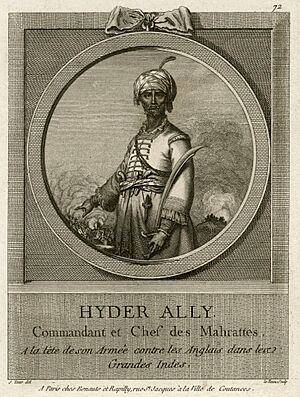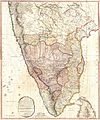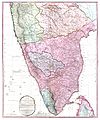Anglo-Mysore Wars facts for kids
The Anglo-Mysore Wars were four big fights in the late 1700s. They were between the Sultanate of Mysore and the British East India Company. Other groups like the Maratha Empire and the Kingdom of Hyderabad also joined in.
Hyder Ali and his son, Tipu Sultan, led Mysore. They fought the British from many directions. The Nizam of Hyderabad also attacked from the north. The Fourth Anglo-Mysore War ended with Tipu Sultan's death in 1799. Mysore lost much of its land. The British East India Company gained a lot of power in India.
Contents
Major Wars Between Mysore and Britain
First Anglo-Mysore War (1767-1769)
The First Anglo-Mysore War (1767 – 1769) was a success for Hyder Ali. He almost captured Madras. The British convinced the Nizam of Hyderabad to attack Ali. But the Nizam soon signed a new deal with the British.
Hyder Ali had to fight British armies from two sides. Still, his attack on Madras made the British ask for peace. This led to the Treaty of Madras.
Second Anglo-Mysore War (1780-1784)
The Second Anglo-Mysore War (1780 – 1784) had many bloody battles. Power shifted between the two sides. Tipu Sultan defeated British commanders William Baillie and John Braithwaite. They were taken prisoner to Srirangapatna.
Sir Eyre Coote, a British commander, returned to fight. He defeated Hyder Ali at the Battle of Porto Novo. Tipu continued the war after his father died. The war ended with the Treaty of Mangalore in 1784. This treaty put things back to how they were before the war.
Third Anglo-Mysore War (1790-1792)
In the Third Anglo-Mysore War (1790 – 1792), Tipu Sultan was an ally of France. He attacked the Kingdom of Travancore in 1789. Travancore was a British ally.
British forces were led by Charles Cornwallis. The war lasted three years. It was a big defeat for Mysore. The war ended after the Siege of Seringapatam (1792) in 1792. Tipu had to give half of his kingdom to the British and their allies. This was part of the Treaty of Seringapatam.
Fourth Anglo-Mysore War (1798-1799)
The Fourth Anglo-Mysore War (1798 – 1799) saw the death of Tipu Sultan. Mysore lost even more land. Mysore's alliance with France worried the East India Company. So, Mysore was attacked from all sides.
Mysore had 35,000 soldiers. The British had 60,000 troops. The Nizam and the Marathas attacked from the north. The British won a big victory at the Siege of Seringapatam (1799). Tipu was killed defending his city.
Most of Mysore's remaining land was taken by the British, the Nizam, and the Marathas. A small part of Mysore was given back to the Indian prince Krishnaraja Wadiyar III. His grandmother ruled for him. The Wadiyar dynasty had ruled Mysore before Hyder Ali. They continued to rule the small kingdom until 1947. Then, it joined the Dominion of India.
After the Wars
These wars, along with others like the Anglo-Maratha Wars and Anglo-Sikh Wars, helped the British take control of South Asia. This led to the British Raj, which was British rule in India. Some groups, like the Afghans and Burmese, continued to fight against British rule for many years.
Rockets
The Mysorean rockets used by Tipu Sultan were very advanced. They used iron tubes to hold the fuel. This made them more powerful and able to fly farther (up to 2 kilometers).
After Tipu Sultan's defeat, the British captured some of these iron rockets. They were very important for British rocket development. They inspired the Congreve rocket, which was later used in the Napoleonic Wars.
See Also
- Mysorean invasion of Malabar
- Battle of Nedumkotta
- Regiment de Meuron
- Garrison Cemetery, Seringapatam
Images for kids
-
The First and the Second Anglo-Mysore War.







